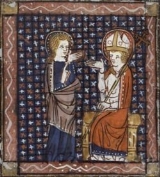
Bricius of Tours
Encyclopedia
Saint Brice of Tours
(Latin: Brictius) (c. 370 – 444) was the fourth Bishop of Tours, succeeding Martin of Tours
in 397.
According to legend, Brice was an orphan
rescued by Martin and raised in the monastery at Marmoutiers
. He later became Martin's pupil, although the ambitious and volatile Brice was rather the opposite of his master.
As Bishop of Tours, Brice performed his duties, but was also said to succumb to worldly pleasures. After a nun
in his household gave birth to a child that was rumored to be his, he performed a ritual by carrying hot coal
in his coat to the grave of Martin, showing his unburned coat as proof of his innocence. The people of Tours, however, did not believe him and forced him to leave Tours; he only could return after he travelled to Rome and was released of his all his sins by the Pope.
After seven years of exile in Rome, Brice returned to Tours when the administrator he had left in his absence died. He was a changed man. Upon returning, he served with such humility that he was venerated as a saint upon his death. His memorial day is 13 November. The killing of the Danes in England on 13 November 1002 is called the St. Brice's Day massacre
.
In the town of Stamford
in Lincolnshire
, November 13, St. Brice's Day, was traditionally the day that a bull-running took place. There is a display on the now banned custom in Stamford Museum in the town.
Tours
Tours is a city in central France, the capital of the Indre-et-Loire department.It is located on the lower reaches of the river Loire, between Orléans and the Atlantic coast. Touraine, the region around Tours, is known for its wines, the alleged perfection of its local spoken French, and for the...
(Latin: Brictius) (c. 370 – 444) was the fourth Bishop of Tours, succeeding Martin of Tours
Martin of Tours
Martin of Tours was a Bishop of Tours whose shrine became a famous stopping-point for pilgrims on the road to Santiago de Compostela. Around his name much legendary material accrued, and he has become one of the most familiar and recognizable Christian saints...
in 397.
According to legend, Brice was an orphan
Orphan
An orphan is a child permanently bereaved of or abandoned by his or her parents. In common usage, only a child who has lost both parents is called an orphan...
rescued by Martin and raised in the monastery at Marmoutiers
Marmoutier Abbey (Tours)
Marmoutier Abbey, also known as the Abbey of Marmoutier , was an early monastery outside Tours, Indre-et-Loire, France. In its later days it followed the Benedictine order as an influential monastery with many dependencies....
. He later became Martin's pupil, although the ambitious and volatile Brice was rather the opposite of his master.
As Bishop of Tours, Brice performed his duties, but was also said to succumb to worldly pleasures. After a nun
Nun
A nun is a woman who has taken vows committing her to live a spiritual life. She may be an ascetic who voluntarily chooses to leave mainstream society and live her life in prayer and contemplation in a monastery or convent...
in his household gave birth to a child that was rumored to be his, he performed a ritual by carrying hot coal
Coal
Coal is a combustible black or brownish-black sedimentary rock usually occurring in rock strata in layers or veins called coal beds or coal seams. The harder forms, such as anthracite coal, can be regarded as metamorphic rock because of later exposure to elevated temperature and pressure...
in his coat to the grave of Martin, showing his unburned coat as proof of his innocence. The people of Tours, however, did not believe him and forced him to leave Tours; he only could return after he travelled to Rome and was released of his all his sins by the Pope.
After seven years of exile in Rome, Brice returned to Tours when the administrator he had left in his absence died. He was a changed man. Upon returning, he served with such humility that he was venerated as a saint upon his death. His memorial day is 13 November. The killing of the Danes in England on 13 November 1002 is called the St. Brice's Day massacre
St. Brice's Day massacre
The St. Brice's Day massacre was the killing of Danes in the Kingdom of England on 13 November 1002, ordered by King Æthelred the Unready. The name refers to St Brice, fifth century Bishop of Tours, whose feast day is 13 November.-Background:...
.
In the town of Stamford
Stamford, Lincolnshire
Stamford is a town and civil parish within the South Kesteven district of the county of Lincolnshire, England. It is approximately to the north of London, on the east side of the A1 road to York and Edinburgh and on the River Welland...
in Lincolnshire
Lincolnshire
Lincolnshire is a county in the east of England. It borders Norfolk to the south east, Cambridgeshire to the south, Rutland to the south west, Leicestershire and Nottinghamshire to the west, South Yorkshire to the north west, and the East Riding of Yorkshire to the north. It also borders...
, November 13, St. Brice's Day, was traditionally the day that a bull-running took place. There is a display on the now banned custom in Stamford Museum in the town.

